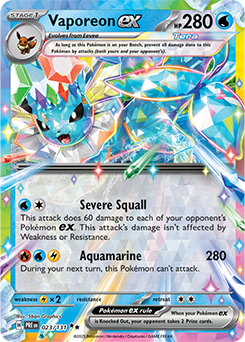New Pokémon TCG products and content are continuing to be revealed by The Pokémon Company. Read on below to learn more:
Learn how to put together a deck for your favorite Eevee Evolution!
It’s been a few months since Scarlet & Violet—Prismatic Evolutions came out, popularizing the previously obscure Pokémon Eevee and its eight Evolutions in the process (we kid!). The expansion is still giving with the launch of more Pokémon TCG special collections, including the just-released Scarlet & Violet—Prismatic Evolutions Super-Premium Collection.
To celebrate the lasting legacy of this incredible expansion, we’ve done the unthinkable: we’ve gathered eight Pokémon TCG experts to give us their thoughts on each of Eevee’s Evolutions. Take those cool cards out of the binder and give them a shot in your next Pokémon TCG battle!
Tord Reklev
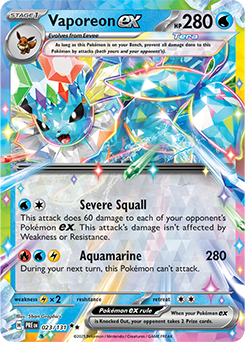
Although Vaporeon ex might not look like the strongest of Eevee’s Evolutions, it features a couple of strong attacks. The Severe Squall attack can damage all of the opponent’s Pokémon ex, which could be great in certain board states. In an ideal scenario, you could be doing 60 damage to six Pokémon for a total of 360 damage! More realistically, the attack will be able to hit one or two Pokémon, but that’s still not a bad deal for only two Energy. Remember that Tera Pokémon ex cannot be damaged by this attack while they’re on the Bench, but an Active Tera Pokémon like Charizard ex can still take damage.
The spread damage from Severe Squall can help set up for Vaporeon ex’s second attack, Aquamarine, which does an impressive 280 damage. The Energy cost can be a little bit difficult to fuel at first glance, but a trick that Vaporeon ex (and all other Eevee Evolutions) have is the opportunity to use Glass Trumpet on Eevee before evolving to accelerate Energy into play.
Usually on these high-damage attacks there is some sort of drawback, and with Aquamarine, Vaporeon ex can’t attack on the following turn. Vaporeon ex, Flareon ex, and Jolteon ex all share a secondary attack with the same attack cost and drawback. Be sure to include plenty of switching options to negate this effect. I would also suggest including Vaporeon ex together with Flareon ex and Jolteon ex to take advantage of the shared attack costs and use Weakness to your advantage!
Christopher Schemanske
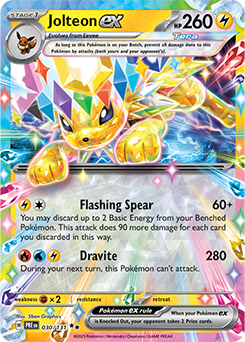
The Lightning Pokémon! What do we have to work with here? Jolteon ex boasts solid fundamentals, with 260 HP and an electrifying free Retreat Cost. Its Dravite attack is a nice option, with 280 damage being a good way to address much of the format, but that’s a lot of Energy to commit—Fire, Water, and Lightning? In this format?
On the other hand, Flashing Spear is significantly more in the spirit of our Lightning-type friend: fast, nimble, and explosive. All we need to do is to get enough Energy on the board to discard two of them every turn! The beauty of Flashing Spear requiring only Lightning Energy is that we can afford to pair a different type to achieve the Bench acceleration. Sure, it’s nice to be able to use Dravite, but if Darkness Energy is what we can accelerate, it’s what we should use.
“Just get more Energy in play” is harder than it sounds, but the Standard format has some great things to offer, and what I especially like about Jolteon ex is the wide range of partners that could support that attack. Hydrapple ex, Glass Trumpet / Terapagos ex, and Teal Mask Ogerpon ex are all capable partners—in fact, you could draw some parallels between the highly successful Raging Bolt ex / Teal Mask Ogerpon ex deck. The fun here is in trying different types to see what works best—Jolteon ex is ready to light things up!
Natalie Millar
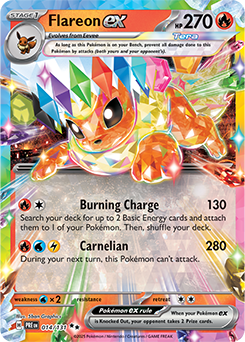
Flareon ex is a super interesting card that can work in a variety of ways. Its Burning Charge attack is an extremely useful setup attack in the early game—because it gets any Energy type, you can use it to power up the multi-Energy attacks on any of Eevee’s other Evolutions! You can also power up Regigigas’s Jewel Breaker attack to trade with massive Tera Pokémon, or even Iron Hands ex’s Amp You Very Much to take extra Prize cards.
Attacks like Burning Charge allow you to go back through older expansions and find cards that have really strong attacks but never managed to see competitive success because they were too difficult to power up. I’ve had a great time scrolling through the set lists of some of the older Scarlet & Violet expansions trying to find cards that were always on the cusp of being successful but just needed an attack like Burning Charge to make their attacks usable.
Carnelian is a solid attack too—280 damage is nothing to scoff at. If I were to play Flareon ex in a deck, I would try to focus on just a few main types, as you don’t want to dilute your deck. However, if you’re splashing one more type to use a powerful Stellar Tera Pokémon, that’s OK. You can also give up on using Carnelian if you have a strong enough attacker to power up (something like Hydreigon ex or Flygon ex). There are a ton of options with building a Flareon ex deck, and I’m excited to see what attackers it’s paired with!
Xander Pero
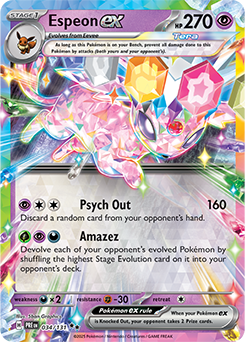
Espeon ex makes up for its lack of raw power with its potential to play mind games with your opponent, especially in the Expanded format. Let’s focus on its first attack, Psych Out, which does 160 damage and discards a random card from your opponent’s hand. Though this isn’t impressive if the opponent has many cards in hand, there are multiple ways we can reduce the opponent’s hand size to hopefully stick them with an unplayable hand.
Unfair Stamp and Iono are two powerful ways to drop an opponent’s hand size throughout the game. If we really want to lean into our discard strategy, we could include Krookodile, which discards a card from the opponent’s hand upon Evolution.
Some supporting Pokémon we can include are Xatu and the also newly released Leafeon ex. We can power up an Espeon ex in a single turn with a Double Turbo Energy and a single use of Xatu’s Ability, Clairvoyant Sense. As for Leafeon ex, it could be useful to deal with any nefarious Darkness-type Pokémon that could prey upon Espeon ex’s Weakness.
One wacky comeback idea would be to include Regigigas VSTAR. Imagine the disbelief on your opponent’s face when you play Counter Catcher, use Star Guardian to discard their invaluable attacker, reset their hand to one card with Iono, then promptly discard it with Psych Out. Espeon ex can leave your opponent in shambles!
Ross Cawthon

Umbreon ex has a unique attack, Onyx, which directly gives you a Prize card at the cost of discarding all of Umbreon ex’s Energy. Is this ever better than simply Knocking Out an opponent’s Pokémon? It can be! The advantage of this attack is your opponent does not get to choose a new Active Pokémon, or benefit from effects like Fezandipiti ex ’s Flip the Script. To take advantage of this, you’ll want to play cards like Counter Catcher, Calamitous Wasteland, and Accompanying Flute to get a Pokémon that can’t attack you into the Active Spot and keep it there.
Meanwhile, you need a way to charge up Umbreon ex again and again. I’d use cards like Blissey ex, Glass Trumpet, Sparkling Crystal, and Powerglass. Blissey ex’s Happy Switch can move Energy to Umbreon ex after it discards them using Onyx. Glass Trumpet can get two Energy attached to two Blissey ex as long as you have a Tera Pokémon like Umbreon ex in play. Sparkling Crystal and Powerglass are two Pokémon Tools that you can attach to Umbreon ex to make your attacks easier to charge.
While Umbreon ex’s more interesting attack is Onyx, its Moon Mirage attack is also important for this strategy. If your opponent only has good attackers in play, your normal “trap” strategy won’t work. That’s when you can rely on Umbreon ex’s Moon Mirage to confuse the attacking Pokémon. Then your opponent will be stuck relying on coin flips while you take a Prize card every turn. Or you could go ahead and use Moon Mirage again for a Knock Out if they have no backup attacker.
Ellis Longhurst
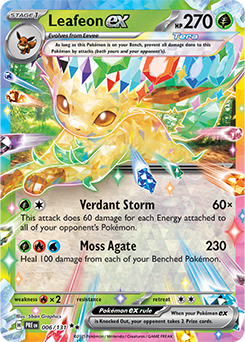
The grass will be greener with Leafeon ex on your side of the battlefield. Its Verdant Storm attack can do more damage to the opponent’s Active Pokémon than any of the attacks of the other Eevee Evolutions. If the opponent has six or more Energy in play, Verdant Storm will Knock Out any Pokémon ex or Pokémon VSTAR in one hit! Leafeon ex is a natural fit for a deck that already includes Eevee or Eevee ex and has space for a Grass Energy, so prepare for this Pokémon to be the situational brawn in all the Eevee Evolution decks.
It is reasonable to have concerns about Leafeon ex as the main attacker because an opponent who is careful with their Energy card attachments can manage the damage done by Verdant Storm. However, Orbeetle (in the Expanded format) and Pokémon League Headquarters might make you turn over a new leaf. Orbeetle’s Jamming Attachment Ability enables you to attach up to 3 Energy cards from the opponent’s discard pile to their Pokémon, while Pokémon League Headquarters encourages your opponent to put more Energy into play to attack with their Basic Pokémon.
There is merit in building a Leafeon ex deck that focuses on using Moss Agate too. This attack is guaranteed to do loads of damage, and it creates an opportunity to deny the opponent Prize cards through creative partnerships. Consider playing Rigid Band or Jasmine’s Gaze to reduce the damage done to Leafeon ex by the opponent’s attacks, then using Slowbro’s Strange Behavior Ability followed by Moss Agate to heal all the damage.
Stéphane Ivanoff
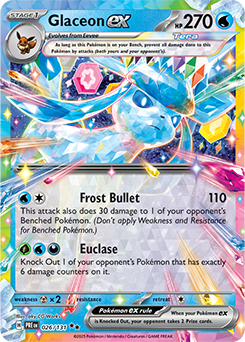
Glaceon ex‘s most striking feature is its Euclase attack, which can Knock Out any Pokémon, no matter its HP—even if it’s on the Bench!—as long as it has exactly six damage counters on it. But how do we put six damage counters on a Pokémon? Simply using an attack that does 60 damage every other turn would be too slow.
Here’s my suggestion: Cofagrigus‘s Law of the Underworld puts six damage counters on every Pokémon that has an Ability. By using it once, we can set up every Pokémon with an Ability to then be Knocked Out by Euclase.
Of course, this plan has flaws. Since Law of the Underworld also damages our own Pokémon with an Ability, it makes it hard to run the Eevee that has Boosted Evolution (the best one, usually). Instead, it is safer to replace it with an Eevee that doesn’t have an Ability, like the one from Scarlet & Violet—151 with the Colorful Friends attack.
Cofagrigus also forces us to run Psychic Energy, in addition to the three types needed for Glaceon ex. While this makes the deck clunkier, cards like Sparkling Crystal and Glass Trumpet (which can power up Eevee or Eevee ex before it evolves!) still give reasonable ways to power up Glaceon ex.
And what about an opponent who doesn’t play Pokémon with Abilities? In this case, I recommend using Glaceon ex’s Frost Bullet to KO small Pokémon while putting damage on bigger targets. After two attacks from Frost Bullet, a Benched Pokémon will have 60 damage on it, so it can be Knocked Out by Euclase!
Robin Schulz

Sylveon ex’s Angelite has got to be one of the strongest attacks in the game currently. It might not take any Prize cards, but getting rid of two Pokémon at once is not to be underestimated. When building a deck around Sylveon ex, we need to focus on how to use this option as effectively as possible, which is why I’ve chosen Dusknoir and Pidgeot ex as its partners.
Dusknoir gives us even greater control over the opponent’s board—instead of taking out two threats in one turn, we can now target three! Many decks won’t be able to recover from that, especially when paired with a late-game Iono. Since Dusknoir makes the deck rather combo-heavy and mandates the inclusion of Rare Candy anyway, Pidgeot is the perfect engine to bring it all together.
Perhaps the most important question is how to satisfy Angelite’s colorful Energy cost. Since I’ve gone with an Arven-based build, Sparkling Crystal is an easy inclusion that makes the task much easier. We’ll likely need more than that throughout a game, so I’ve also included Crispin. As a Supporter card, it’s harder to set up combos with Iono, but it’s still a very simple and effective option. If you’re a fan of Sylveon, you’ll definitely have a lot of fun with this card!
Tord Reklev

Tord Reklev is a contributing writer for Pokemon.com. He is a longtime player from Norway, playing the game since he was 6 years old. In becoming Champion at the 2022 Latin America International Championships, Tord is the first player to win all four International Championships and complete the Grand Slam. Outside of the game, he is a student and enjoys playing tennis. You can find him at most big events and can follow him on X at @TordReklev.
Christopher Schemanske

Christopher Schemanske is a contributing writer for Pokemon.com. He’s been playing the Pokémon TCG since 2010, with a streak of Worlds invitations between 2012–2018. Nowadays, he enjoys splitting his Pokémon time between playing and being part of the awesome Professor staff teams at major events.
Natalie Millar

Natalie has been playing Pokémon casually since late 2013 but started attending more competitive tournaments in late 2017. She won the first Regional Championships after the pandemic in her home city of Brisbane, Australia, and has been attending most major tournaments since. Outside of Pokémon, she studied psychology, but it doesn’t help with reading opponents as much as you would think. You can find her at most major tournaments and can follow her on X at @nataliem9999.
Xander Pero

Xander Pero is a contributing writer for Pokemon.com. He was an avid fan until discovering sanctioned tournaments in 2009. He formerly traveled often for the Top 16 circuit, but now spends his time focusing on university, where he studies industrial engineering. You can find him at various tournaments, as well as on X at @xanderpero.
Ross Cawthon

Ross Cawthon is a longtime player, starting to play tournaments in 2000. He is the only player to compete in all 20 Pokémon TCG World Championships, finishing as a finalist in 2005 and 2011, and a semifinalist in 2016. He is known for creating many new “rogue” decks over the years. Ross has a Ph.D. in astrophysics and studies dark energy (not to be confused with Darkness Energy cards).
Ellis Longhurst

Ellis Longhurst is a contributing writer for Pokemon.com. She has been competing in high-level Pokémon TCG tournaments since 2006 and creating written content for the Pokémon community since 2011. Now she brings some Australian flavour to the Play! Pokémon commentary teams at the International and World Championships.
Stéphane Ivanoff

Stéphane Ivanoff is a contributing writer for Pokemon.com. A longtime Pokémon fan, he has played the Pokémon TCG competitively since 2010 and is a former National Champion, seven-time Worlds competitor, and the 2018 and 2019 North America International Champion in the Masters Division. He studied mathematics and has a degree in Probability and Statistics, but he says that doesn’t help his game as much as you’d think! You can follow him on X @lubyllule.
Robin Schulz

Robin Schulz is a contributing writer for Pokemon.com. He has been competing in Pokémon tournaments for 10 years and was the Pokémon TCG Masters Division World Champion in 2018. He spends a lot of time traveling and competing, and he rarely misses a big event. Aside from playing Pokémon, he attends university, where he is studying mathematics.
Source: The Pokémon Company International
Source: Pokemon

